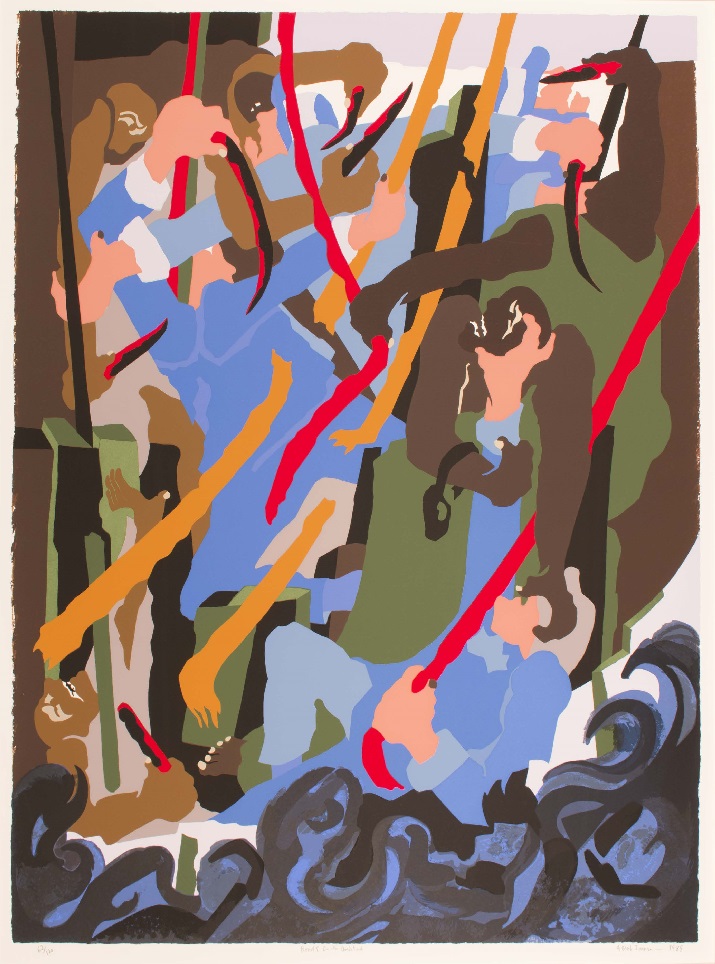This week I have been immersed in the life and work of Jacob Lawrence, one of the best-known artists of the Harlem Renaissance as well as one of America’s foremost modern artists. Lawrence, who got his start painting scenes of everyday life in Harlem in the 1920s and 1930s, rose to dizzying prominence by the early 1940s.1 In general, art historians have focused on this early period of his life, roughly before his service in the Coast Guard during World War II.2 For this blog post, I would like to highlight his late career, when he incorporated a new medium—silkscreen—into his artistic practice.
Drafted in 1943, Lawrence was originally assigned to a segregated unit of Black stewards, as were most Black men in the Coast Guard. His gallerist Edith Halpert and other supporters intervened to have him assigned to work as a combat artist aboard the U.S.S. Sea Cloud, a converted yacht assigned to weather patrol in the North Atlantic. Notably, the Sea Cloud was among the first desegregated crews in the military during the war, and Lawrence used his position in the Coast Guard’s public relations arm to advocate for further desegregation of the armed forces.3 After the war and later in his career he worked at Black Mountain College alongside Joseph Albers and other modernist luminaries before decamping to the West Coast and the University of Washington. It was during these later years at UW that he embarked on a series of silkscreens—most of them adaptations of earlier paintings—in collaboration with Lou Stovall, a Washington, D.C.-based master printmaker. Revolt on the Amistad, in CFAM’s permanent collection, is a particularly fine example of Lawrence and Stovall’s collaboration.

Stovall, who is still active today, reminisced about his collaboration with Lawrence in 2002, at the opening of the exhibition Over the Line: The Art and Life of Jacob Lawrence, organized by the Phillips Collection shortly after Lawrence’s death in 2000.4 Stovall recalls the intensity of their collaboration, which took place in face-to-face meetings enhanced by long hours spent on the phone going over each proof. Silkscreen, which is also known as serigraphy, was particularly well-suited to Lawrence’s style. Since his early days as a painter, Lawrence had used unmixed gouache, an opaque style of watercolor. This allowed him high levels of control over his color, enabling him to use exactly the same shades every time he put brush to paper. It also resulted in his signature bright colors, which he used to great effect in his representations of African American history and culture. As Stovall recalls, this made his work particularly suited to silkscreen, in which a printer applies each color individually.5 Recalling their work on Revolt on the Amistad, Stovall remarked that “Using silkscreen printmaking at its best, Jacob was able to compare the state of one proof to another, as he adjusted his composition to suit his idea. What happened and how to represent what happened on the deck of La Amistad mattered to him. His knowledge of history told him about the violent struggles, slashing knives, and gnashing teeth set against the colors of rope, skin, and uniform, with the turbulence of the waves lifting the ship.” 6
Revolt on the Amistad was in so many ways a culmination of Jacob Lawrence’s life’s work, which was to blend the bright colors and dynamic forms of high modernism with the pain, struggle, triumph and hope of Black life in America. I urge you to take some time with it and follow those twisting forms, reflecting on the violence of the action as well as the hope represented by those Black men and women risking their lives for freedom.
1 R. Blakeslee Gilpin, “TOGETHER UNDER ARMS: Jacob Lawrence Paints Black History,” in John Brown Still Lives!, America’s Long Reckoning with Violence, Equality, and Change (University of North Carolina Press, 2011), 159,
2 Maurice Jackson, “‘Friends of the Negro! Fly with Me, The Path Is Open to the Sea’: Remembering the Haitian Revolution in the History, Music, and Culture of the African American People,” Early American Studies 6, no. 1 (2008): 92.
4 Jacob Lawrence et al., Over the Line: The Art and Life of Jacob Lawrence (Seattle,; London: University of Washington Press in association with Jacob and Gwendolyn Lawrence Foundation, Seattle and New York., 2000). Lou Stovall, “Working with Jacob Lawrence: An Elegy,” Columbia: A Journal of Literature and Art, no. 36 (2002): 192–98.
5 Stovall, “Working with Jacob Lawrence,” 195–97.
6 Stovall, “Working with Jacob Lawrence,” 195–96.

